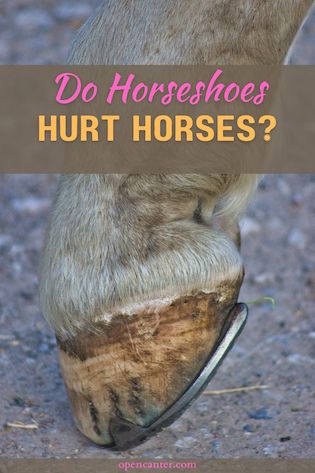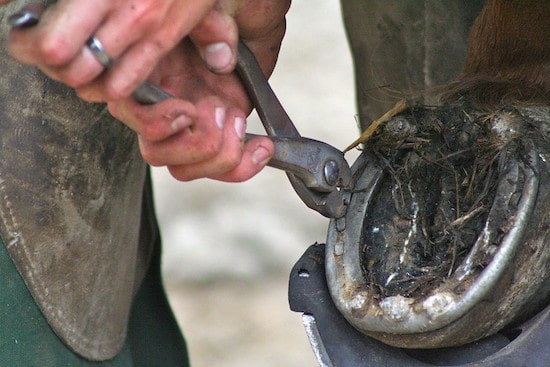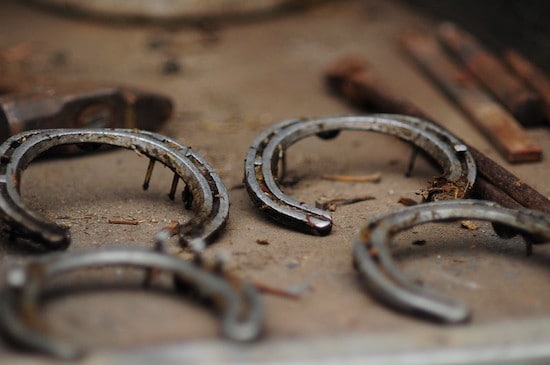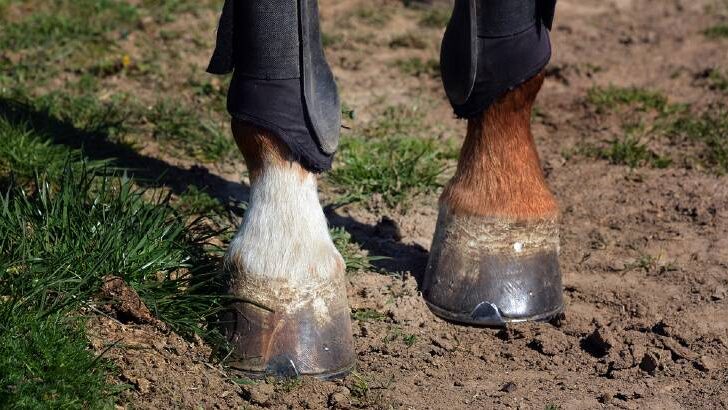Affiliate Disclaimer
As an Amazon Associate I earn from qualifying purchases. It helps me keep the website going. Thank you for your support.
Horseshoes are a piece of riding equipment that has been debated for some time. Some owners shoe their horses because it supports their hooves, while others say going barefoot is better for hoof health. Since the hoof is the horse equivalent to a human foot, some equestrians may find themselves asking- do horseshoes hurt horses?
It does not hurt a horse to wear horseshoes because the shoes are placed on the outer wall of the hoof, which has no nerves. As a result, horses do not feel any pain when the shoes are nailed on, but they can be painful if a farrier places them incorrectly.
All equestrians want to ensure their horse is well cared for and stays pain and injury free. So, read on to find out more about horseshoes and explore whether or not they cause pain in different scenarios.

Do Horseshoes Hurt When They Are Being Put On?
Whenever a farrier installs new horseshoes on a horse’s hooves, they use their expertise to fit them correctly. However, does it hurt the horse when they are being put on?
It does not hurt the horse to get new horseshoes because the nails that the farrier uses are placed in the part of the hoof wall that does not have nerves.
The only time shoeing can be painful is if the farrier places the nail in the wrong place. Nails should be placed closer to the toe rather than the heel of the hoof.
When horseshoes are put on wrong, they rub on the tissue and sole of the frog which is painful and leads to lameness
Horses can feel pain in their hoof because of the soft tissues and nerve endings in the frog and other structures besides the hoof wall.
Diseases can infect these areas and cause lameness and other painful conditions.
Horses can also be sedated during the shoeing process so that they do not feel anything including the trimming of their hoof.
People in the horse industry are unsure if horses like getting shoes put on. Most don’t seem to mind, and others are neutral about the process.
The Horseshoeing Process
To give you a better idea of what the shoeing process is like for horses, here are the steps normally involved:
- The farrier picks and cleans out the hoof
- They remove old shoes if needed, also painless
- They trim and file the hooves down
- They nail the new shoes on
- They file the hooves down again so that they do not overgrow

The whole process is designed to be safe and comfortable for the horse while helping them maintain hoof health.
What Are the Benefits of Horseshoes?
Although some equestrians prefer to leave their horses barefoot, there are many benefits to wearing them, including:
- Prevention of hoof wear and sole protection
- Reshaping during horseshoe placement prevents hoof problems
- Corrective shoeing helps with damage and prevents further injury from laminitis and other hoof conditions
- Provision of traction to avoid slipping and help your horse cross difficult terrain
- Support for horses with an uneven or high-stepping gait, or for horses that move at high speeds
- Horseshoes absorb shock from the horse’s movement
Horseshoes are a great tool for many horses and they help keep them sound and pain-free. However, not every horse needs to wear shoes.
When Should a Horse Wear Shoes?
Horses should wear horseshoes when they are in consistent work (2x or more a week) to protect their hooves.
Horseshoes are also recommended for horses involved in eventing, reining, or other sports that require constant movement.
Your horse may not need shoes if they are in partial or full retirement, have minimal to no conformational faults, have hard feet, and or no other health problems. You can read more about what horses did before shoes here.
It is always best to consult with your vet before making shoeing decisions to ensure the best outcome for your horse.
Even if your horse is barefoot, they still need to have its hooves trimmed to prevent them from getting too long and affecting movement.

Do Horseshoes Hurt When Horses Wear Them?
Since the horseshoes are attached in a pain-free area, they do not hurt a horse to wear.
The only time they may hurt is when a horse pulls a shoe and it damages their hoof wall or another part of their body.
When a horse pulls a shoe, it is usually because its hind leg extends too far forward and pulls the shoe off the front hoof.
Although the horse may not feel pain when this happens, it could cause unknown damage to the hoof wall.
Some horses tend to play rough in the pasture, so they can hurt their hooves that way.
Do Horseshoes Hurt If They Get Damaged?
This depends on the extent of the damage to the shoe. If the horseshoe has regular wear from use, it will not hurt and just needs to be replaced.
Horses need new shoes every 4-6 weeks to protect the hoof and replace any lost nails due to hoof growth.
However, if the shoe partially breaks and it has sharp edges, it can hurt the hoof if the horse continues to move with it.
Horseshoes are typically made of metal, which is heavy and can do a lot of damage on its own. But there are new rubber horseshoes that are softer and cannot form sharp edges
Why Don’t Wild Horses Wear Shoes?
Wild horses have more durable hooves, and their hooves naturally wear down as they move in search of food and other resources.
Domestic horses do not have the same hoof quality or ability to move over varied terrain. As a result, they need to have their hooves trimmed regularly by a farrier.
Final Thoughts
Do horseshoes hurt? Horseshoes only hurt if they are installed improperly. This is because the nails used to put them in place are hammered into the hoof wall. The hoof wall has no nerves, so the procedure is not painful for horses. Horseshoes are not supposed to cause a horse pain for any reason.




